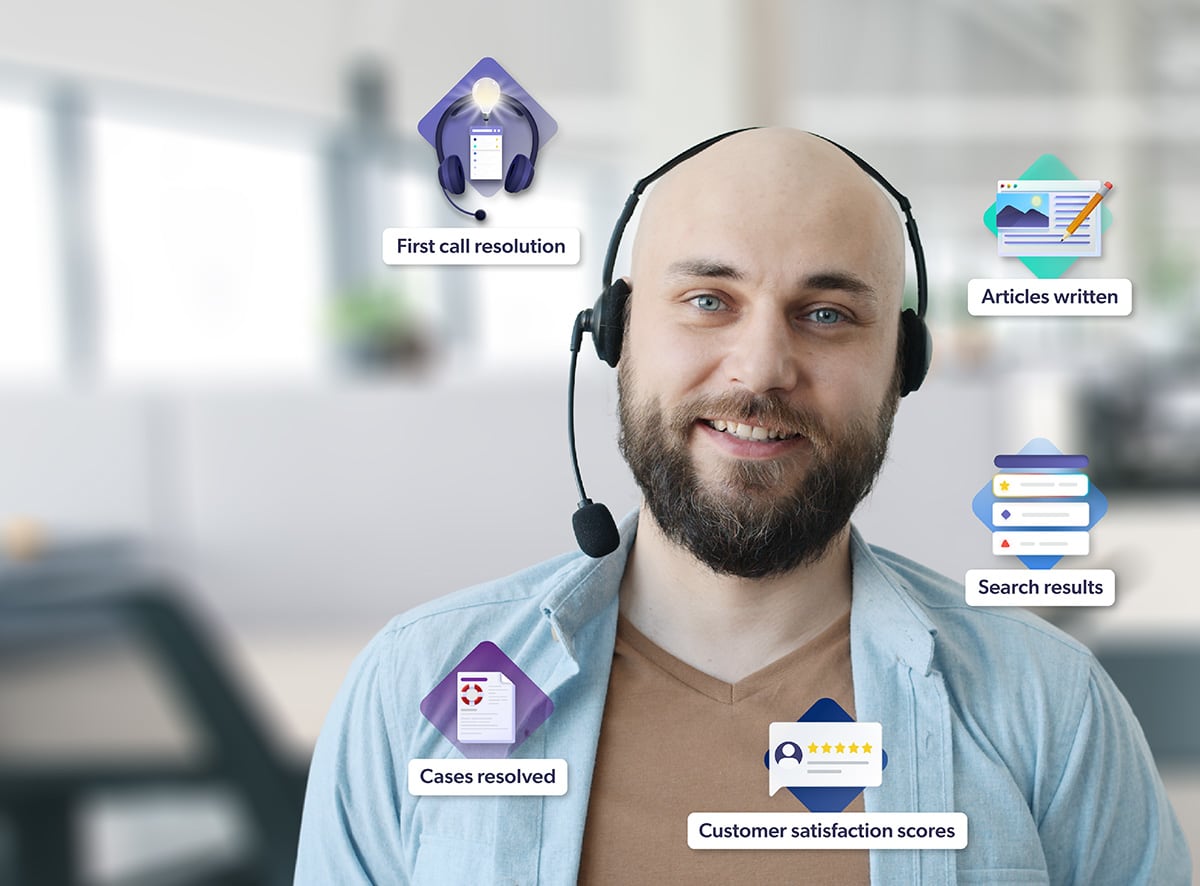Increasingly, companies compete on customer experience. Delivering superior customer experience has been shown to increase sales revenue, profitability, and shareholder return by up to 10%.
To support these efforts, many organizations turn to customer experience technology. Customer relationship management (CRM) platforms come to mind, as do contact center platforms and knowledge management (KM) platforms. New developments in artificial intelligence (AI) have given way to more diverse, user-oriented forms of customer self-service.
What actually qualifies as customer experience technology? How can you use it to measure customer satisfaction and deliver personalized experiences? And how do business leaders identify the right customer experience technology to support these efforts?
Let’s dig in.

What Is Customer Experience Technology?
In and of itself, customer experieCustomer experience is a broad concept. Most definitions center around the relationship between a business and its customer.
HubSpot defines customer experience as “the impression your customers have of your brand as a whole throughout all aspects of the buyer’s journey.” Forrester focuses on how customers perceive your brand.
Customer experience technology includes any tool or tech that helps companies deepen their relationships with customers. We like this particular definition of customer experience technology from ClearAction Continuum:
“A tool to nurture relationships that anticipate what a customer would appreciate, in the right way, at the right time,” and “involve other functional areas across the company in gaining an accurate picture of customers’ needs, so that they can make sure their processes, policies, and handoffs help strengthen customer relationships.”
Given this definition of customer experience technology, it’s easy to see the straight lines that many enterprises draw between customer experience and business outcomes. The benefits of customer experience technology can be far reaching.
In a study by RingCentral, the implementation of just one such technology — a contact center platform — led to the following benefits:
- 18% revenue boost
- 10% decrease in operational costs
- 16% improvement in customer ratings
- 17% increase in agent productivity
Your choice of technology matters, too.
According to Metrigy, migrating to a hybrid Contact Center as a Service (CCaaS) costs about $1,356 per agent per year. Consider this against the cost of an on-premises contact center, which is about $2,104 per agent per year.onsider this against the cost of an on-premises contact center: $2,104 per agent per year.

As any contact center decision maker knows, cost factors directly into customer experience.
Customer Experience Management (CXM)
An important aspect of customer experience, CXM is a means for orchestrating the strategies and processes needed to elevate each customer interaction — no matter where or how it happens.
More often than not, CXM strategies include a variety of customer experience technology. While there are many ways to use technology to create a better customer experience, Harvard Business Review recommends striking a balance between empathy and technology.
That means starting with what customers need and want before implementing the corresponding technologies. In practice, this approach to CXM can look different for different industries.
In 4 Personalized Service Examples: An Exploration Across Industries, you’ll find some contemporary applications. How the insurance industry is unifying product lines around people, for example. Or how the wealth management industry uses existing customer data to personalize product recommendations.
While CXM might vary from company to company, few disagree on its importance.
UX vs CX — What’s the Difference?
Don’t confuse UX with CX! Though the lines do tend to blur, the two terms are not interchangeable. If, as we’ve said, customer experience is the sum of each customer’s perception of their interactions with a company or brand, UX is more focused on the experience a person has while using the product or service.
In some cases, the customer and end user are the same. But not all.
Writing for Usability Geek, Caroline White reminds us that UX is usually more focused on particular apps, websites, or even programs.
For more, see UX Best Practices that drive Customer Satisfaction.

What Are The Types of Customer Experience Technology?
That the market for CX technology is saturated is an understatement. Pick just one aspect of CX, such as email automation, and you’ll find a towering list of potential solutions.
Writing for CMSWire, journalist Phil Britt highlights some categories of CX technology to prioritize:
Customer data management
Customer data management refers to the process of capturing and storing customer data across channels. Today, that data can come from a variety of customer interactions (web, store, etc.) and channels (contact center, retail, etc.).
Regardless of your data management model, you’ll need a system for collecting, grouping, enriching, and integrating customer data.
Cloud-based solutions
One of the main advantages of cloud-based solutions is the ability to integrate and scale new experiences without costly tech overhauls. Aside from their scalability, cloud-based solutions tend to be more secure, redundant, and flexible for the needs of global enterprises.
Omnichannel technology
Contrary to popular belief, customers don’t mind switching channels. Gartner found that they’re amenable to toggling between service channels; but what they want is recognition that leads to resolution. Consistency and accuracy. They expect companies to recognize them when they come back or switch to another mode of interaction.
To orchestrate this level of continuity and personalization — across channels and touch points — requires scalable omnichannel solutions.

AI for customer service
Have you used a customer self-service portal lately? Maybe you were surprised at how relevant (or maybe irrelevant) the experience was. The best customer self-service applications adopt AI search to use both behavioral data and historical data to customize results for customers, especially taking into account products or services they might have.
And AI search can extend customer recognition into the assisted-support side of things. A customer service agent that already knows about your issue, product, and recent history, for example. Rather than asking you to repeat yourself, or transferring you to another agent, they’re quickly solving your issue on the spot.
With AI, this level of proactive support is possible, both for customer self service and agent-assisted interactions.
Predictive analytics
What if you could provide solutions before customers even ask for them?
“Hey, John Smith. Based on our data, your water filter expires soon. Should we send you a new one?”
With predictive analytics and AI, enterprises can extract this kind of insight — the kind that stands to deepen and enrich the customer relationship.
Authentication and identification management
The funny thing about authentication and identity management is that, for as advanced as the tech now is, username/password issues still generate tons of cases.
Investing in authentication and identification management can make logging in easier and allow for seamless personalization (while reducing repetitive username/password queries).
What Is an Example of Customer Experience Technology?
AI chatbots remain one of the most discussed and debated examples of customer experience technology. For a couple of reasons:
- Chatbots can be deployed across a variety of channels (service, sales,etc.);
- They’re often powered by AI and machine learning, which can learn and adapt to improve CX on the fly;
- and they’re a terrific source of customer behavior data.
Thing is, your chatbot is only as good as the information — the enterprise content — it can fall back on in the often-occuring event a customer asks a question that falls outside of its carefully constructed rules-based responses. By linking your chatbot to a unified index, you imbue it with the ability to suggest relevant content that can help answer questions and potentially deflect support cases.
For example, AARP embeds Coveo-powered chatbots throughout their text channels, help site, and Facebook Messenger. This allows AARP to deliver service relevance to more than 38 million members, whether they need immediate self-service (chat), or help after hours (text).e than 38 million members, whether they need immediate self-service (chat), or help after hours (text).

With the help of Coveo, the aforementioned RingCentral uses chatbots to deflect cases and enhance customer experience, making particular use of predictive recommendations. These chatbots are plugged into a unified index, personalized, and available 24/7.
Of course, chatbots are but one example of customer experience technology. You’ll find plenty of enterprises with augmented reality, CRM systems, and speech analytics supporting their broader CXM strategies. You can even bring relevant content within your product via In-Product Experience, so customers don’t have to leave their flow of work when a question or issue strikes.
What Does a Strong Customer Experience Strategy Look Like?
We’ve come a long way from an exclusive focus on efficiency and cost-cutting. Those are still important objectives for a CX strategy, but the focus has shifted to building end-to-end customer experiences.
This includes deep personalization throughout all aspects of CX, including digital customer experience, employee experience, and the use of behavioral data.
Central to this push are AI search platforms, of which Coveo is a category leader. It’s the Coveo Relevance Platform, for instance, that helps Bass Pro Shops boost conversions and revenue-per-visitor across its ecommerce experiences. Thanks to sophisticated journey mapping, testing, and tech integrations, any visitor to Bass Pro Shops will enjoy an experience that feels tailored to their needs — whether they’re a camper, fisher, or otherwise.
Across these and other examples, you’ll find three key ingredients to a forward-thinking CX strategy, namely:
- Identify who customers are and what they’re trying to accomplish
- Build specific teams to solve specific problems
- Implement the right customer experience technology
| CX Strategy Case Study: ULI ULI supports more than 45,000 members worldwide, 83% of which consider access to valuable content a primary reason for their membership. Knowing this about their user base, ULI enlisted Coveo to create Knowledge Finder, a go-to resource hub for thousands of resources and exclusive content pieces. The impact on CX has been significant. Read the full ULI case study. |
Important Considerations for CX Technology
How your business deploys these technologies matters.
Consumer Attitudes Toward CX Automation
A recent Verizon survey of 5,000+ people in 16 countries revealed some eye-opening insights.
- More than half of customers don’t mind a fully automated interaction
- 78% of respondents think a blended (technology and human) interaction is better than just human-only
- For people ages of 18 and 34, it’s possible to have a “human connection” in a 100% automated interaction
Here’s the thing. According to the same survey, 62% of respondents prefer direct human interaction for customer service issues. As we know, customer service is a critical component of CX.
The Importance of Privacy, Transparency, and Security
More than a third (34%) of people said they’d cease interacting with a company if that company shared their personal data without consent. And 65% think it’s important for companies to tell them when an interaction is powered by a bot, instead of a human being.
Customers have other valid questions, too:
- What kind of data are you collecting?
- Is the experience compliant with HIPAA and other data privacy regulations
- Will I get accurate and reliable information?
And finally, is the experience secure? You don’t have to look far for recent examples of massive data breaches, strong evidence of the continual evolution of the threat landscape. CX technology is not immune to cybersecurity concerns. Failing to address them can turn minor issues into major headaches.
How Has Technology Changed Customer Experience?
There was a time that a touchless, cardless checkout at a professional sporting event was science fiction. Now, modern arenas across the United States are making this kind of experience a reality for everyday fans.
At Climate Pledge Arena in Seattle, for example, you’ll find Amazon One and Just Walk Out technology shaping the concessions experience throughout most concourses. Customers just scan their palm or credit card, grab what they want, and head back to their seats — no more waiting in line for that hot dog.
This is just one example of how high-tech touch points are changing both in-person and digital CX. As the authors at HBR note, you’ll find three characteristics behind high-tech touch points:
- Fictionless commerce
- Augmented experiences
- Intuitive interactions
Expect the level of automation and personalization to expand even further in the coming years, especially given the new advancements in three core technologies:
Generative AI (GenAI)
GenAI opens new doors for fully automated, yet highly personalized customer experiences. Today, a customer can receive generated answers through their familiar search bar or self-service portal with nearly the same dynamism and personalization that come from human interactions. It’s just that good.
You can imagine the real-world use cases that embedded GenAI supports:
- Ecommerce: Personalized shopping assistant that guides shoppers to what they need.
- Service: Self-service experiences that adapt to customer input while reducing cost to serve.
- Employees: An always-on copilot that can do everything from generate marketing campaigns to provide tailored sales coaching.
With GenAI, you can spin up conversational interfaces to any internal and external channel that’s tied to customer experience. Salesforce Agentforce is a good example. Their new AI “agents” can be customized to help employees on the job, enrich customer experiences, and automate key aspects of customer service.
For more, read our State of Generative AI report.
Cloud Computing
In many ways, cloud computing has leveled the playing field in CX: what used to be a diamond-in-the-rough experience can now be reliably scaled to global audiences. For the enterprises investing in customer experience technology, cloud computing makes the effort more efficient, secure, and scalable.
For the intended audience of this technology, cloud computing offers better performance, data consistency, and personalization. Still, 63% of IT professionals are struggling to manage their cloud environments, even as cloud computing sales continue to soar.
Why Data is so Critical to Customer Experience Technology
Data is crucial to building a customer-centric culture and, by extension, getting the most out of customer experience technology. With the right data architecture in place, it’s possible to develop a deep understanding of customer expectations.
Habits and buying preferences, interaction history and preferred communication channels — all of this data and more can be used to learn, meet, and predict customer expectations. Yet, leading enterprises aren’t just supporting CX technology with data — they’re building data-driven, customer-centric strategies.

Four strategies can help you get theFour strategies can help you get there:
1. Appoint a Customer Experience Leader
Teams dedicated to CX are noticeably missing from most organizations. In our experience, dedicated CX leadership tends to bring cohesion to the various processes, people, and technologies that make up customer experience.
2. Get to Know Your Customers Using Data
One powerful source of customer data is search analytics. Every day, customers are telling you what they’re looking for, the problems they’re encountering, and their level of intent. Companies that can capture and act on these analytics stand to significantly boost their CX.
3. Establish Best Practices for Positive CX
These best practices extend far beyond customer satisfaction scores and wait times. What standards do you have in place across the channels your customers use to communicate with your business? What about the new customers you bring on? Are they aligned with your goals and objectives? Ask the hard questions about CX, even in the places you least think to look.
4. Use Data to Test and Refine Your Approach
Rolling out new CX technology is all well and good. But what impact is it really having? Are there adjustments you can make based on customer feedback? To refine your approach, make sure you:
- Measure user adoption
- Analyze customer behavior
- Test different support channels
- Build out comprehensive customer self-service tools
How Do You Measure Customer Experience?
To measure the effectiveness of CX, look at two things: what customers are telling you and what customers are actually doing. With regard to the former, we tend to measure CX effectiveness in two ways:
- Customer journey mapping, in which you visualize every experience and touchpoint.
- Common CX metrics, such as CSAT, net promoter score (NPS), customer effort score (CES), and customer lifetime value (CLV).
When measuring customer behavior across the end-to-end journey, the possibilities are many. For example, in ecommerce you can see how products and campaigns perform based on placement, to determine what’s resonating with customers based on how they interact.
In the customer service space, you can identify content gaps based on search language that doesn’t turn up a result from the knowledge base. You can then use that data to inform changes (publish a new KB article, for example).
Many support teams will measure the volume of certain issue types. If they notice a spike, the data can help pinpoint what’s causing the issue, possibly informing an improvement to the product improvement or elsewhere across the digital customer experience.
Dig Deeper
The modern enterprise must constantly improve its CX. They need scalable solutions for enhancing website search, customer self-service portals, and ecommerce platforms — any and all touchpoints across the journey. Coveo is here to help. Reach relevant prospects with advanced CX technology.


